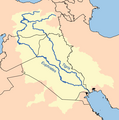The Gardening Portal

Gardening is the process of growing plants for their vegetables, fruits, flowers, herbs, and appearances within a designated space. Gardens fulfill a wide assortment of purposes, notably the production of aesthetically pleasing areas, medicines, cosmetics, dyes, foods, poisons, wildlife habitats, and saleable goods (see market gardening). People often partake in gardening for its therapeutic, health, educational, cultural, philosophical, environmental, and religious benefits. Gardening varies in scale from the 800 hectare Versailles gardens down to container gardens grown inside. Gardens take many forms, some only contain one type of plant while others involve a complex assortment of plants with no particular order. (Full article...)
Horticulture is the science and art of growing fruits, vegetables, flowers, or ornamental plants. Horticulture is commonly associated with the more professional and technical aspects of plant cultivation on a smaller and more controlled scale than agronomy. There are various divisions of horticulture because plants are grown for a variety of purposes. These divisions include, but are not limited to: propagation, arboriculture, landscaping, floriculture and turf maintenance. For each of these, there are various professions, aspects, tools used and associated challenges; Each requiring highly specialized skills and knowledge of the horticulturist. (Full article...)
General images -
Selected article -

The List of Narcissus horticultural divisions is a classification of the cultivated varieties of the genus Narcissus (/nɑːrˈsɪsəs/), which are predominantly spring perennial plants in the family Amaryllidaceae. Most species and cultivars are known by the common name daffodil, while a few are called jonquils.
The list of Narcissus horticultural divisions provided by the Royal Horticultural Society (RHS) is the standard method used to classify and describe cultivated varieties (cultivars) of Narcissus. It is widely used since the RHS is the international authority for the registration of such cultivars. For horticultural purposes, all Narcissus cultivars are split into 13 divisions, as described by Kington (1998), for the RHS, based partly upon flower form (shape and length of corona – the "trumpet" or "cup"), particularly the ratio of corona to length of perianth segments (tepals or "petals"), the number of flowers per stem, flowering period and partly upon the genetic background. Division 11 (Split-corona) with its two subdivisions was the most recent group to be described (1969). Division 13, which includes all the wild rather than cultivated daffodils, is the exception to this scheme. This classification is a useful tool for planning planting. Most commercially available narcissi come from Divisions 1 (Trumpet), 2 (Large-cupped) and 8 (Tazetta). (Full article...)
Selected image

Related portals
Did you know -
- ... that Xu Garden was created by community residents grateful to their local warlord?
- ... that former New Jersey first lady Lucinda Florio restored the Italianate gardens at Drumthwacket?
- ... that the Cranford Rose Garden at Brooklyn Botanic Garden was cited as having 1,200 varieties of roses?
- ... that Nizza in central Frankfurt is one of the largest gardens of Mediterranean plants north of the Alps, thanks to its very warm microclimate?
- ... that The Lord of the Ice Garden, a Polish novel series mixing elements of fantasy and science fiction, has been compared to The Witcher?
- ... that Mel Bartholomew, who developed the time-saving square foot gardening method, said that he gardened "with a salad bowl in mind, not a wheelbarrow"?
- ... that the Shakespeare garden in Wessington Springs, South Dakota, was the first of its kind in the state?
- ... that controversy ensued when the painting Pleasure Garden was offered to the Robert McDougall Art Gallery?
Things you can do
- This list is transcluded from the tasks list page. To edit the list, click here
 |
Here are some tasks awaiting attention:
|
WikiProjects
Topics
Categories
Associated Wikimedia
The following Wikimedia Foundation sister projects provide more on this subject:
-
Commons
Free media repository -
Wikibooks
Free textbooks and manuals -
Wikidata
Free knowledge base -
Wikinews
Free-content news -
Wikiquote
Collection of quotations -
Wikisource
Free-content library -
Wikiversity
Free learning tools -
Wiktionary
Dictionary and thesaurus































































































